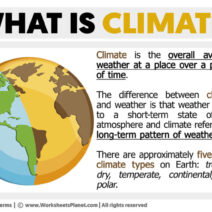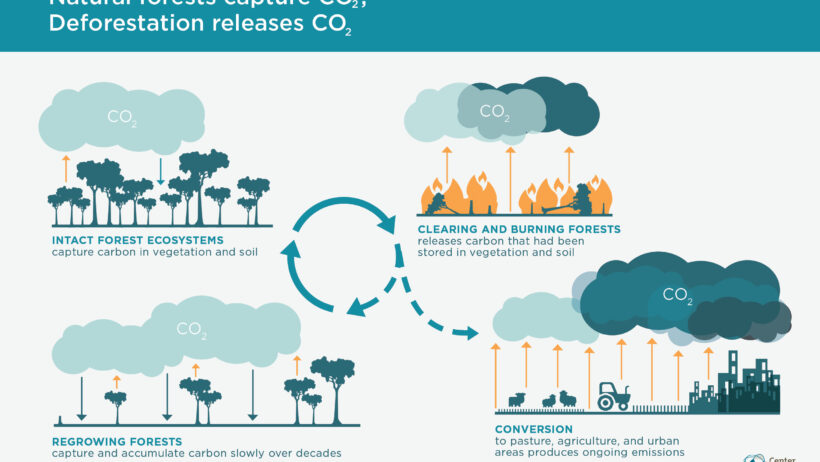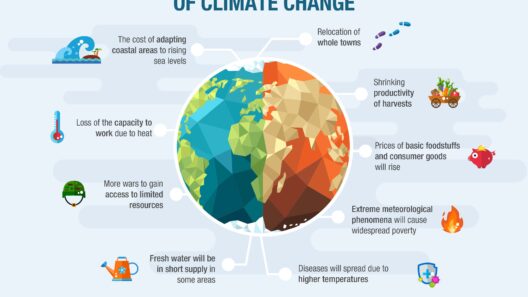Deforestation is a global crisis, characterized by the large-scale removal of trees from forested areas, transforming vibrant ecosystems into barren lands. This catastrophic phenomenon plays a pivotal role in driving climate change, exacerbating global warming through the release of stored carbon dioxide (CO2) and disrupting essential ecological processes. Understanding how deforestation contributes to climate change, alongside viable strategies to mitigate its impact, is crucial for fostering environmental resilience and sustainability.
Forests serve as critical carbon sinks, sequestering vast quantities of CO2 from the atmosphere. According to the World Resources Institute, approximately 1.1 billion acres of forest are lost annually due to deforestation, primarily for agricultural expansion, logging, and urban development. This not only diminishes the global ability to absorb greenhouse gases but also releases enormous amounts of CO2, as trees, when cut down or burned, unleash their stored carbon back into the atmosphere. It is estimated that deforestation is responsible for about 10% to 15% of total global greenhouse gas emissions, a staggering figure that highlights the urgent need for intervention.
Moreover, the effects of deforestation extend beyond merely carbon emissions. Forests maintain local and regional climates by regulating temperature and hydrological cycles. The removal of trees disrupts the balance of water vapour and precipitation, leading to altered rainfall patterns. This phenomenon can result in more severe droughts in certain regions while causing flooding in others. The loss of forests, therefore, not only contributes to climate change but can also render areas uninhabitable, displacing communities and threatening biodiversity.
Additionally, forests are home to 80% of terrestrial biodiversity. The destruction of these habitats results in the extinction of countless species, undermining the intricate web of life that sustains ecosystems. In the face of climate change, these ecosystems are essential for resilience and adaptation. Biodiversity offers myriad ecological services—pollination, pest control, and nourishment—critical for agriculture and ensuring food security. The intertwined relationship between deforestation and biodiversity loss underscores an urgent necessity to combat this destructive trend to preserve both ecosystems and the countless species they harbor.
Addressing the nexus between deforestation and climate change necessitates a multifaceted approach. First and foremost, implementing sustainable land-use practices is crucial. Agroforestry, for instance, integrates trees into agricultural landscapes, enhancing productivity while preserving carbon stocks. By staggering traditional agricultural practices with sustainable techniques, emissions can be curtailed while simultaneously promoting food security.
Policies aimed at regulative enforcement also play an essential role. Governments must strengthen laws against illegal logging and land conversions. Substantial fines and penalties can serve as deterrents to corporations and individuals who prioritize profit over ecological wellbeing. Enforcing sustainable logging practices, such as selective logging and minimal impact techniques, can mitigate the negative consequences of deforestation while allowing for responsible resource extraction.
Investment in reforestation and afforestation initiatives is another pivotal strategy. Reforesting degraded land can restore the carbon-absorbing capacity of forests, while afforestation—planting trees in areas that were not previously forested—can expand carbon sinks. Organizations and governments should engage local communities in these efforts, as indigenous knowledge is invaluable for determining which species to plant based on ecological compatibility and community needs.
Furthermore, enhancing awareness and education surrounding deforestation’s ramifications is crucial. Communities should be informed about the long-term impacts of their choices, particularly in regions where resource extraction is prevalent. Education can empower individuals to advocate for sustainable practices and hold industries accountable, forging a culture of conservation rather than consumption.
Public-private partnerships can also catalyze change. Collaboration between governments, non-profits, and businesses can yield innovative solutions to address deforestation. For instance, companies can adopt zero-deforestation commitments, ensuring that their supply chains do not contribute to habitat loss. Corporate social responsibility initiatives can also promote environmentally friendly practices, demonstrating that profitability is achievable alongside ecological stewardship.
International cooperation is paramount in addressing the global issue of deforestation. Climate change knows no borders; thus, collective action through frameworks like the Paris Agreement can encourage nations to commit to reducing deforestation rates. Financial support for developing nations, particularly those that harbor critical forests, can be instrumental in their transition toward sustainable development and forest conservation. Through initiatives like REDD+ (Reducing Emissions from Deforestation and Forest Degradation), countries can receive financial incentives for reducing deforestation, thus fostering a global commitment to climate action.
In conclusion, the threat posed by deforestation to climate change is undeniable. It is a complex issue where ecological, social, and economic factors intertwine. By adopting sustainable land-use practices, enforcing strict regulations, investing in reforestation, raising awareness, forming public-private partnerships, and fostering international cooperation, we can mitigate the harmful effects of deforestation. Empowering communities and promoting a culture of conservation will be essential in this endeavor. The preservation of our forests is not merely an environmental imperative; it is a necessity for the survival of humanity and the ecological integrity of our planet.




